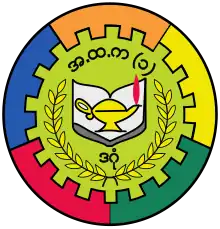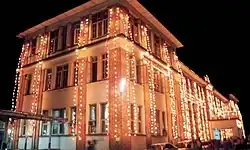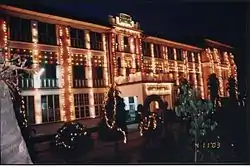| Designations | |
|---|---|
| Basic Education High School No. 1 အခြေခံ ပညာ အထက်တန်း ကျောင်း အမှတ် (၁) ဒဂုံ | |
|---|---|
 | |
 | |
| Address | |
57 Alanpya Pagoda Road Dagon 11191 , | |
| Information | |
| Type | Public |
| Motto | We all love Dagon(1) |
| Established | 1882 |
| School number | 1 |
| Principal | Daw Sanda Mya Nyein |
| Faculty | 150 |
| Grades | kindergarten to 12 |
| Number of students | 1500+ |
Basic Education High School No. 1 Dagon (Burmese: အခြေခံ ပညာ အထက်တန်း ကျောင်း အမှတ် (၁) ဒဂုံ; formerly, Methodist English High School; commonly known as ဒဂုံ ၁ ), located a few miles north of downtown Yangon is considered one of the best public high schools in Myanmar. Dagon 1 offers classes from kindergarten to tenth standard (recently renamed Grade 1 to Grade 11) to about 6500 students.
Attended almost exclusively by the children of the wealthy, Dagon 1 has some of the best educational facilities available in a Burmese private school. The school routinely sends a disproportionate share of outstanding students to the country's most selective universities each year. Its most famous alumna is the Nobel Peace Prize Laureate Aung San Suu Kyi.[1] Many of the Burmese entertainment industry's top stars are Dagon 1 alumni. Dagon 1 in recent year has lost some of its appeal as a top school as ultra-wealthy parents now send their children to expensive English language medium "international" private schools.[2]
The school's main colonial era building is on the Yangon City Heritage List.[3]
History

The school was founded in 1882 as Methodist Episcopal Girls School on Lewis Street (now Seikkantha Street). In 1894, the school was moved to its current campus on the corner of Lancaster Road (now Nawaday Road) and Signal Pagoda Road, and was also renamed Methodist English Girls High School. The school consisted primarily of a three-story Victorian-era style building 213 feet (65 m) long and 145 feet (44 m) wide. At first, boys were accepted only in the elementary level (from K to 3). During the interwar period, boys were allowed from K to 4. Just before World War II, the school had 55 students. The school was closed down for 6 years after World War II and later reopened in May, 1947. The principal, Mrs. Logie, repaired the school buildings that were destroyed during the war. At that time, the school began to prepare its students not only for the matriculation exam but also for the GCE (General Certificate of Education) exam from the University of London.
In 1951, the number of students increased to 850 and the four-story Kindergarten building (113'×51') with 15 rooms was built in 1952 to accommodate the students. The school's name was Methodist English High School (MEHS). On 14 April 1965, the institution was nationalized and became a public school and has been operated by the government ever since. In 1986, a new three-story building (90'×34') was built to correspond to the increased number of students. The school is currently running under the Department of Basic Education which is directly controlled by the Ministry of Education.
During 1988 democracy uprising, Dagon1 was one of the first high schools in Burma to form student union and participate in the protest boycott marches. Throughout the uprising, members of Dagon1 student union lead their fellow students and teachers in various protest marches. Dagon1 protest column can be clearly distinguished amongst other columns by their Green Flag with White Fighting Peacock emblem, former official flag of All Burma Federation of Student Unions and the green and white represents the uniform colours of high school students. After September 1988 coup by the military, some of dagon1 students went to Thai-Burma border and joined All Burma Student Democratic Front (ABSDF) to achieve democracy and human rights in Burma through armed struggle.
References
- ↑ Whitney Stewart (1997). Aung San Suu Kyi: Fearless Voice of Burma. Twenty-First Century Books. ISBN 978-0-8225-4931-4.
- ↑ Sandra Davie (13 October 2008). "I see no future for my two sons in Myanmar". The Straits Times. Singapore.
- ↑ "Special Reports: Heritage List". The Myanmar Times. 29 October 2001. Archived from the original on 15 June 2009.